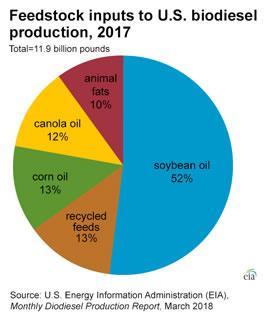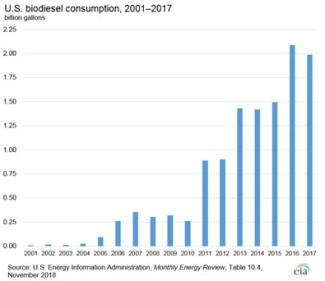Learn About Transportation Biodiesel
Find answers to your questions about Transportation Biodiesel:
What is biodiesel?
Biodiesel is a renewable fuel that is made from vegetable oils, grease, and animal fats. Biodiesel fuel has chemical features similar to petroleum-based diesel so that it can be used as a direct substitute for diesel fuel. Biodiesel can also be blended with petroleum diesel in any percentage without reducing vehicle fuel economy. The primary sources of raw material for making biodiesel in the United States and their shares of biodiesel feedstocks in 2017 were:

*Rapeseed oil, sunflower oil, and palm oil are major feedstocks for biodiesel production in other countries.
What is the difference between diesel and biodiesel fuel?
Diesel fuel is a nonrenewable fuel made from petroleum. Biodiesel is a renewable fuel made from vegetable oils, grease, and animal fats.
How is biodiesel made?
Biodiesel is made through a chemical process called transesterification through which the glycerin is separated from the fat or vegetable oil. This process leaves behind two products: methyl esters (which is the chemical name for biodiesel) and glycerin (an important byproduct usually sold to be in soaps and other products).
Why should you use biodiesel?
Biodiesel is better for the environment because it is made from renewable resources and has lower emissions compared to petroleum diesel. It is less toxic than table salt and biodegrades as fast as sugar. It is also made with natural resources; its use decreases the dependence on imported fuel and contributes to our economy.
Global biodiesel consumption
Biodiesel’s environmental benefits, ease of use, availability of federal and state financial and other incentives, and the federal Renewable Fuels Standards (RFS) contributed to the growth in U.S biodiesel consumption grew from about 10 million gallons in 2001 to about 2 billion gallons in 2017.

Many countries encourage the use of biodiesel. In 2001, global biodiesel consumption was about 0.3 billion gallons. Fifteen years later, in 2016 about 9.3 billion gallons of biodiesel were consumed in at least 56 countries, and 58% was consumed in five countries.
World biodiesel consumption, 2016
|
|
Billion gallons |
Share of world total |
|
World total |
9.3 |
|
|
United States |
2.1 |
22% |
|
Brazil |
1.0 |
10% |
|
France |
0.9 |
10% |
|
Indonesia |
0.8 |
9% |
|
Germany |
0.7 |
7% |
|
All others |
3.9 |
42% |
Biodiesel FAQ's
Many fleet managers have determined that biodiesel is their least-cost-strategy to comply with state and federal regulations.
Biodiesel can be operated in any diesel engine with little or no modifications to the engine or the fuel system. Biodiesel has a solvent effect that may release deposits accumulated on tank walls and pipes from previous diesel fuel storage. The release of deposits may clog filters in the beginning and precautions should be taken. Confirm that only fuel meeting the biodiesel specification is used.
Biodiesel blends are also used as heating oil. Biodiesel can be stored and transported using petroleum diesel fuel tanks and equipment.
Biodiesel can be made available anywhere in the US. A current list of registered fuel marketers is available on the biodiesel website at biodiesel.org or by calling the National Biodiesel Board (NBB) at (800) 841-5849.
Biodiesel is an advanced biofuel, reducing lifecycle carbon emissions by up to 86%.
